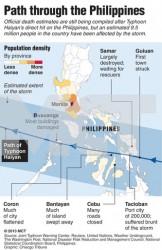Niles West Filipino Students React to Typhoon Haiyan

Niles West High School logo.
Nov 13, 2013

Had it not been for his father’s gut feeling to come home early, 17-year-old Wes would not be safe and communicating via Facebook with his sister, Nicole Dimaculangan, a senior at Niles West. He would have been with his peers and their families as they were holding on to tree branches, hanging on rooftops, floating on debris, and being separated from baby siblings who couldn’t hold on much longer.
Wes is one of the more than 200,000 people who live in Tacloban City, Philippines that was hit by a typhoon (the same thing as a hurricane and a cyclone, as reported by National Public Radio) Friday, Nov. 15 (pacific time).
“From what my brother has told me, there’s hardly any electricity, they use candles, and resources like medicine and food are almost impossible to access with the big amount of people that need it,” Dimaculangan said.
The official death toll from Typhoon Haiyan is unknown, but current numbers indicate that as many as 2,500 people have died.
Because Tacloban City is a peninsula, it is more vulnerable to storms since the ocean surrounds the majority of the land. As reported by the Red Cross, not including landslides and floods, the Philippine islands experience 20-25 typhoons a year.
Dimaculangan, who lived in the area 12 years before moving to the United States, thinks that recovery will take a long time.
“There’s another storm coming, and people are suffering from diseases, they could flood again,” she said.
Although relief and donations have been made to the country, so much more is needed, according to Tacloban City Mayor Alfred Romualdez.
“Of the 400 policemen 30 [survived], most of those who helped carry the bodies and the resources,” he told Anderson Cooper on a live CNN Broadcast.
Senior Samantha Lariosa, who was just in Tacloban City last July, said she knew the area frequently experienced natural disasters, but didn’t expect something like Typhoon Haiyan.
“The area was beautiful and incredibly serene and seemed like it was separate from the world. We knew it was a place easily affected by high and low tide and heavy rainstorms, but it never experienced as bad as this before,” she said.
Senior Ruby Ladrido said she has family members in the affected area from whom she has yet to hear.
“Just a phone call or some word of news is all I can hope for right now,” Ladrido said.
According to English director and Filipino Club sponsor Sanlida Cheng, Filipino Club has plans of fundraising for relief funds these next two weeks.
“Starting [today], Filipino Club members will be canning so you can make a donation directly to a member. Can’t find a student? I will have a donation can in my office (1140), and you can make a donation there,” she said in an email to staff members.
Lariosa urges everyone to donate to the damaged country.
“It’s utter chaos in some areas there. People have lost their houses, belongings, and even loved ones. I’ve heard rioting is going on in some places where help or food is scarce. Anything would help tremendously, even an old shirt in the back of your closet or a couple singles in your wallet,” Lariosa said.



